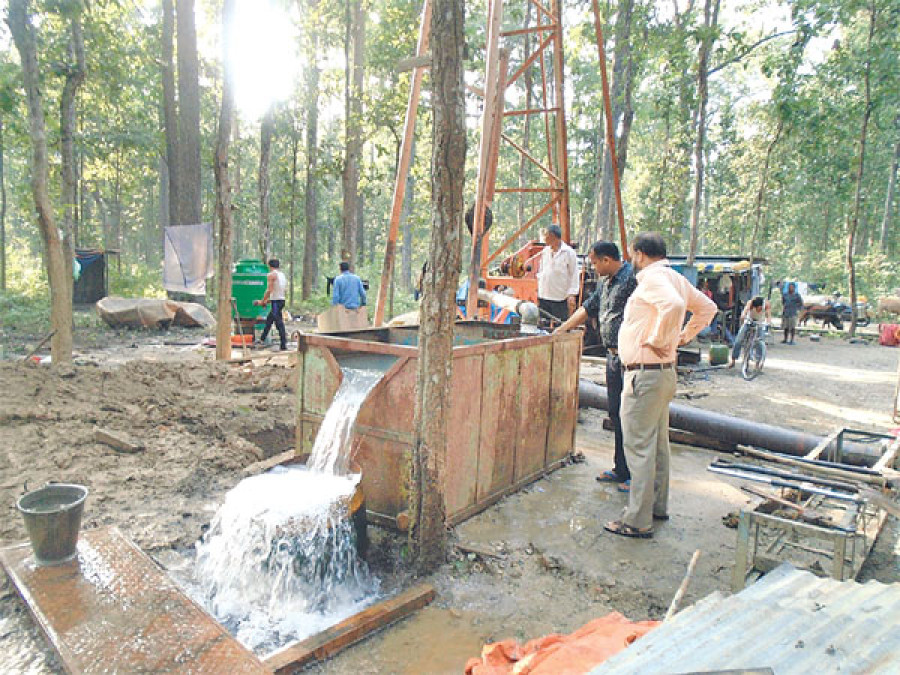National
Small and medium-sized cities are highly prone to water insecurities
Climate change, rapid urbanisation and drying up of natural springs have worsened water crisis in Dharan and Dhulikhel.
Chandan Kumar Mandal
For Subarna Shrestha, a resident of Dharan Sub-metropolitan City, water shortage has become a significant problem in the last decade. Rainy season offers the much-needed respite, but once the dry season sets in, residents grapple with water scarcity.
“It has been nearly 15 years since we started facing water crisis in the city,” Shrestha told the Post. “Now, we don’t have any option than to buy water from tanker owners. A tanker of water costs Rs2,500-Rs3,000.”
Even the tourism sector has been affected in Dharan, according to Shrestha, who is also a former president of the Hotel Association of Dharan.
Small to medium-sized cities like Dharan in the Himalayan region of Nepal and India, which are witnessing unchecked urbanisation, increasing population, changing lifestyles of residents, coupled with adverse impacts of climate change, are becoming prone to water insecurity, according to a three-year-long study.
The study which was based in four cities—Dhulikhel and Dharan in Nepal and Mussoorie and Haldwani in India—concludes that providing adequate amount and acceptable quality of water for their residents will become an even bigger challenge in the future.
The four cities—urban areas in the low to medium elevation in the Himalayas—have been relying on springs, streams, rivers and groundwater for meeting domestic and commercial water needs, according to the study conducted by Southasia Institute of Advanced Studies (SIAS).
“Water crisis is becoming a global issue because of increased population, rapid urbanisation, growing demand for water for agriculture and industries that require more and more water,” said Roshan Man Bajracharya, principal investigator of the research. “Indian and Nepali cities are also grappling with water scarcity issues. These places are also highly vulnerable to climate change and extreme weather events, which are likely to make water scarcity and its management issues even worse.”
Climate change effects on rainfall patterns like less and irregular rainfall, decrease in wet spell and increase in dry spell period, dying of natural springs were observed across the region. Similar effects of climate change, which would affect the availability of water, were observed in both Dharan and Dhulikhel.
According to a separate study, Dharan is among the cities along the Himalayan foothills facing water insecurity because of its three characters: geologically porous surface, high rainfall belt and ecological connectivity between the plains and the mountains.
Dharan, a city in eastern Nepal, is situated in the Bhavar zone, which is known for its high permeability due to alluvial landscape built up by deposits of unconsolidated sedimentary materials. The study shows that on average 124mm water can penetrate under the ground. Furthermore, rapid urbanisation and increasing population, which grew by 41 percent between 2001 to 2011, made Dharan a water-scarce city.
According to Manju Bhandari, acting mayor of Dharan, the city, which has become a centre and a modern hub of education and health services in eastern Nepal, had also been facing ‘desert-like’ conditions.
“I remember people would go to Itahari, take a room in a hotel and wash clothes all night,” said Bhandari. “Dharan reels from water shortages starting from November-December every year.”
Similar climatic conditions were also recorded around Dhulikhel area, where Rosi Khola has been the major source of water.
According to Ngamindra Dahal, co-principal investigator of the research, climate change had left its effects such as 10.4mm less annual rainfall in the Rosi Khola area, 9.1mm annual precipitation drop around Dhulikhel, shorter wet spell and more extended dry spell.
Likewise, discharge of water from Rosi Khola has been decreasing at 0.01 cubic metre per year as per the data of the last 44 years.
“These numbers may look small but they are significant. With the increasing impacts of climate change, Rashi Khola cannot be a sustainable source for Dhulikhel area,” said Dahal. “Likewise, for improving water situation in Dharan, it needs immediate intervention. Otherwise, the crisis will only worsen for Dharan residents and downstream settlements like Biratnagar and Itahari.”
Unless city-specific climate adaptive and equitable water supply measures are employed effectively, water security issues will be more challenging in years to come, researchers warn.
When climate adaptive measures like recharge ponds were created for revitalising natural springs in the Dhulikhel area, a steady increase in water discharge volume had increased in 10 local springs.
Similarly, Dharan Sub-metropolitan City, which has already prioritised rainwater harvesting for its residents, also introduced a policy of making groundwater recharge pit mandatory for new private and public houses in a bid to mitigate water scarcity.
“The findings of this study have helped us realise the value of groundwater recharge system. We will be introducing a policy that makes it mandatory for houses with more than 20 rooms to have rainwater harvesting system and wastewater treatment plant,” said Dhulikhel Mayor Ashok Byanju. “Water spouts and ponds conservation will be prioritised. Rosi Khola watershed area will be better managed because dying of water resources will affect not only Dhulikhel but also Banepa residents.”
According to Shrestha, a resident of Buddha Marga, locals of Dharan will have a severe future fighting for water needs.
“Rainwater harvest has been popular, but locals hardly know how to keep water for a long time,” said Shrestha. “For families like mine with 15 members, water will be a big headache in the future.”




 16.12°C Kathmandu
16.12°C Kathmandu















